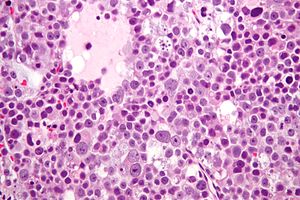Difference between revisions of "Spermatocytic tumour"
Jump to navigation
Jump to search
(+cat.) |
(split-out) |
||
| Line 1: | Line 1: | ||
# | {{ Infobox diagnosis | ||
| Name = {{PAGENAME}} | |||
| Image = Spermatocytic_seminoma_high_mag.jpg | |||
| Width = | |||
| Caption = Spermatocytic seminoma | |||
| Micro = three cell sizes: (1) small cells (6-8 µm) - with a large NC ratio, (2) medium cells (15-18 µm) with prominent nucleoli and spireme chromatin, (3) Large cells (50-100 µm) with spireme chromatin; mucoid lakes, intratubular apread | |||
| Subtypes = | |||
| LMDDx = [[DLBCL]], [[seminoma]] | |||
| Stains = | |||
| IHC = | |||
| EM = | |||
| Molecular = | |||
| IF = | |||
| Gross = | |||
| Grossing = | |||
| Site = [[testis]] | |||
| Assdx = | |||
| Syndromes = | |||
| Clinicalhx = | |||
| Signs = | |||
| Symptoms = | |||
| Prevalence = | |||
| Bloodwork = | |||
| Rads = | |||
| Endoscopy = | |||
| Prognosis = | |||
| Other = | |||
| ClinDDx = other [[germ cell tumours]], [[lymphoma]] | |||
}} | |||
'''Spermatocytic_seminoma''' is a rare benign testicular tumour. | |||
==General== | |||
*Rare tumour. | |||
*Only one case of metastases in 200 cases.<ref name=pmid7927308>{{cite journal |author=Eble JN |title=Spermatocytic seminoma |journal=Hum. Pathol. |volume=25 |issue=10 |pages=1035–42 |year=1994 |month=October |pmid=7927308 |doi= |url=}}</ref> | |||
*Orchiectomy is curative. | |||
*Not reported/found in females.<ref name=pmid7927308/> | |||
*Typically older - mean age 50s.<ref name=pmid7927308/> | |||
===Epidemiology=== | |||
*Does NOT arise from ''[[intratubular germ cell neoplasia]]'' (ITGCN)<ref>{{cite journal |author=Müller J, Skakkebaek NE, Parkinson MC |title=The spermatocytic seminoma: views on pathogenesis |journal=Int. J. Androl. |volume=10 |issue=1 |pages=147–56 |year=1987 |month=February |pmid=3583416 |doi= 10.1111/j.1365-2605.1987.tb00176.x|url=}}</ref> - '''not''' considered a subtype of [[seminoma]]. | |||
==Microscopic== | |||
Features:<ref>{{cite book |author=Cotran, Ramzi S.; Kumar, Vinay; Fausto, Nelson; Nelso Fausto; Robbins, Stanley L.; Abbas, Abul K. |title=Robbins and Cotran pathologic basis of disease |publisher=Elsevier Saunders |location=St. Louis, Mo |year=2005 |pages= |edition=7th |isbn=0-7216-0187-1 |oclc= |doi= |accessdate=}}</ref> | |||
*Population of three cells. | |||
*#Small cells (6-8 µm) - with a large NC [[ratio]]. | |||
*#*Look like secondary spermatocytes. | |||
*#*May be confused with (mature) lymphocytes. | |||
*#Medium cells (15-18 µm) with prominent nucleoli. | |||
*#*Filamentous chromatin (AKA ''spireme chromatin'').<ref name=pmid7927308>{{cite journal |author=Eble JN |title=Spermatocytic seminoma |journal=Hum. Pathol. |volume=25 |issue=10 |pages=1035–42 |year=1994 |month=October |pmid=7927308 |doi= |url=}}</ref> | |||
*#Large cells (50-100 µm). | |||
*#*Filamentous chromatin. | |||
*Mucoid lakes. | |||
*Intratubular spread. | |||
Notes: | |||
*''Spireme'' = the tangle of filaments in prophase portion of mitosis.<ref>URL: [http://www.thefreedictionary.com/spireme http://www.thefreedictionary.com/spireme]. Accessed on: 4 June 2010.</ref> | |||
*May have eosinophilic cytoplasm (dependent on lab). | |||
**Usually larger than [[Leydig cell tumour]]. | |||
DDx: | |||
*[[DLBCL]]. | |||
*[[Seminoma]]. | |||
===Images=== | |||
<gallery> | |||
Image:Spermatocytic_seminoma_high_mag.jpg | Spermatocytic seminoma - high mag. (WC) | |||
Image:Spermatocytic_seminoma_intermed_mag.jpg | Spermatocytic seminoma - intermed. mag. (WC) | |||
</gallery> | |||
==IHC== | |||
Features:<ref name=pmid10223302>{{Cite journal | last1 = Kraggerud | first1 = SM. | last2 = Berner | first2 = A. | last3 = Bryne | first3 = M. | last4 = Pettersen | first4 = EO. | last5 = Fossa | first5 = SD. | title = Spermatocytic seminoma as compared to classical seminoma: an immunohistochemical and DNA flow cytometric study. | journal = APMIS | volume = 107 | issue = 3 | pages = 297-302 | month = Mar | year = 1999 | doi = | PMID = 10223302 }}</ref> | |||
*PLAP -ve (0 positive/17). | |||
*CD117 -ve (7 positive/17). | |||
*CAM5.2 -ve (1 positive/17). | |||
==See also== | |||
*[[Testis]]. | |||
*[[Genitourinary pathology]]. | |||
==References== | |||
{{Reflist|1}} | |||
[[Category:Diagnosis]] | [[Category:Diagnosis]] | ||
[[Category:Genitourinary pathology]] | |||
Revision as of 21:02, 5 July 2013
| Spermatocytic tumour | |
|---|---|
| Diagnosis in short | |
 Spermatocytic seminoma | |
|
| |
| LM | three cell sizes: (1) small cells (6-8 µm) - with a large NC ratio, (2) medium cells (15-18 µm) with prominent nucleoli and spireme chromatin, (3) Large cells (50-100 µm) with spireme chromatin; mucoid lakes, intratubular apread |
| LM DDx | DLBCL, seminoma |
| Site | testis |
|
| |
| Clin. DDx | other germ cell tumours, lymphoma |
Spermatocytic_seminoma is a rare benign testicular tumour.
General
- Rare tumour.
- Only one case of metastases in 200 cases.[1]
- Orchiectomy is curative.
- Not reported/found in females.[1]
- Typically older - mean age 50s.[1]
Epidemiology
- Does NOT arise from intratubular germ cell neoplasia (ITGCN)[2] - not considered a subtype of seminoma.
Microscopic
Features:[3]
- Population of three cells.
- Mucoid lakes.
- Intratubular spread.
Notes:
- Spireme = the tangle of filaments in prophase portion of mitosis.[4]
- May have eosinophilic cytoplasm (dependent on lab).
- Usually larger than Leydig cell tumour.
DDx:
Images
IHC
Features:[5]
- PLAP -ve (0 positive/17).
- CD117 -ve (7 positive/17).
- CAM5.2 -ve (1 positive/17).
See also
References
- ↑ 1.0 1.1 1.2 1.3 Eble JN (October 1994). "Spermatocytic seminoma". Hum. Pathol. 25 (10): 1035–42. PMID 7927308.
- ↑ Müller J, Skakkebaek NE, Parkinson MC (February 1987). "The spermatocytic seminoma: views on pathogenesis". Int. J. Androl. 10 (1): 147–56. doi:10.1111/j.1365-2605.1987.tb00176.x. PMID 3583416.
- ↑ Cotran, Ramzi S.; Kumar, Vinay; Fausto, Nelson; Nelso Fausto; Robbins, Stanley L.; Abbas, Abul K. (2005). Robbins and Cotran pathologic basis of disease (7th ed.). St. Louis, Mo: Elsevier Saunders. ISBN 0-7216-0187-1.
- ↑ URL: http://www.thefreedictionary.com/spireme. Accessed on: 4 June 2010.
- ↑ Kraggerud, SM.; Berner, A.; Bryne, M.; Pettersen, EO.; Fossa, SD. (Mar 1999). "Spermatocytic seminoma as compared to classical seminoma: an immunohistochemical and DNA flow cytometric study.". APMIS 107 (3): 297-302. PMID 10223302.

